by Richard Haney, Executive Director
After this I looked, and there was a great multitude that no one could count, from every nation, from all tribes and peoples and languages, standing before the throne and before the Lamb, robed in white, with palm branches in their hands. They cried out in a loud voice, saying, “Salvation belongs to our God who is seated on the throne, and to the Lamb!” —Revelation 7:9–10
Twice in the Book of Revelation (7:9–10 and 5:7–9), John makes reference to a multitude from every nation, tribe, people and language. This is a gathering of the redeemed who are marked by white robes and palm branches as they shout praises as God’s unified family. Moreover, they represent the ethnic diversity of all the earth’s peoples. Scholars tell us there are more than 6,500 distinct ethnolinguistic people groups across our globe. The New Testament uses the word ethne, though the term is more widely translated as “nations.” (See Matthew’s account of the Great Commission.)
Historian Andrew Walls comments on the early days of the Church as the Gospel spread from one ethne (Jews) to a second ethne (Greeks):
“At that time there were only two communities in the church (or churches) being addressed. Since then Christian cross-cultural diffusion has brought many more into the church, and our own day has seen the greatest proliferation of all. Each is to have, like Jew and Greek in the early church, its own converted lifestyle as the distinctive features of each culture are turned toward Christ. The representation of Christ by any one group can at best be only partial. At best it reflects the conversion of one small segment of reality, and it needs to be complemented and perhaps corrected by others. The fullness of humanity lies in Christ; the aggregate of converted lifestyles points toward his full stature” (Crossing Cultural Frontiers: Studies in the History of World Christianity, 2017).
How do God’s people celebrate their oneness in Christ? In Him we experience unity as well as diversity. We’re different in culture, language and worldview, but we’re united in our devotion to Jesus. Do we appreciate the incredible diversity of peoples like the Kurds, Arsi Oromo, Pashtun, Lakota, Chanao, Fur, Bengali, Suri, Pingilapese, Dizi, Hausa, Fulani and thousands more—and what they contribute to one another’s perspectives on God and His Kingdom? We need more contact and communication with our sisters and brothers who see the world and the Word of God in ways that challenge our own customs and understandings.
The frontier mission enterprise bids disciples pray, give, go and mobilize the global Church to participate in God’s mission to bring the Good News to the remaining unreached people groups who still haven’t heard it. Access to the Gospel means access to Jesus, God’s Word. Such access prepares us for that multicultural worship of the Lamb that will exceed all our expectations.
The pictures of a multiethnic congregation in Revelation signal that one day we’ll all gather together to worship Jesus the Lamb. I can hardly imagine the breadth and depth of that experience. I trust that the beautiful harmonies will overshadow anyone preferring one liturgical style or a particular kind of music. I expect angelic melodies will be added as well. As the Holy Spirit conducts and choreographs the worship, I think it will be breathtaking and breath-giving.
Journey with us through the Advent season with daily reflections from our 2018 devotional, “Behold”—online beginning Saturday, December 1! (Receive posts directly in your inbox when you subscribe to our blog mailing list.)


Comments are closed.